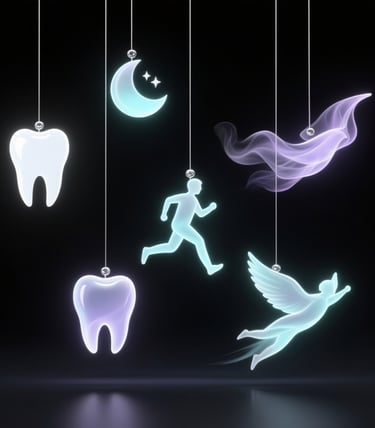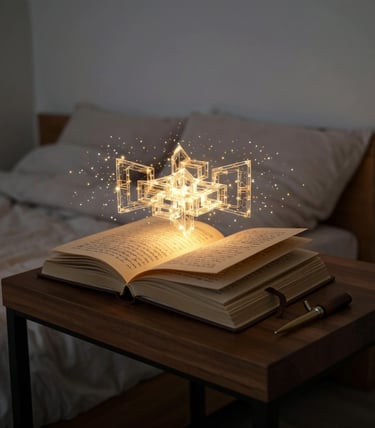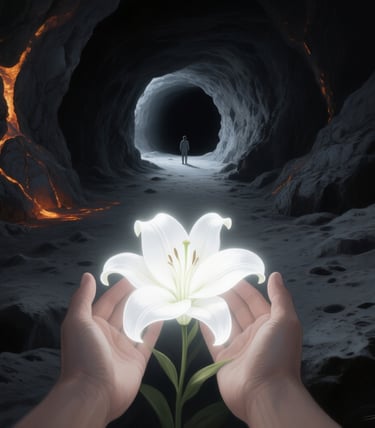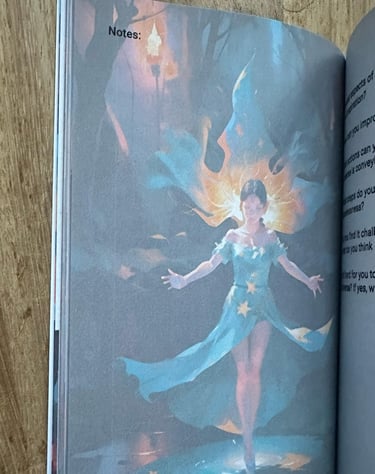
Unlocking the Mysteries of Dreams: A Comprehensive Guide
3/30/20258 min read
This neurological symphony serves several vital functions. Your hippocampus, the brain's memory center, replays and consolidates the day's experiences, effectively transferring them from short-term to long-term storage. Meanwhile, your emotional centers work through unresolved feelings, often helping you process stress or trauma. The power of this process is remarkable; studies, including those from Harvard Medical School, have shown that dreaming about a challenging task can lead to a 20-30% improvement in performance the next day.
Dream Symbolism: The Secret Language of Your Subconscious
Dreams rarely speak to us in plain language. Instead, they communicate through a rich tapestry of symbols and metaphors. While a symbol can be deeply personal, some themes are surprisingly universal. Here’s a look at a few common dream scenarios and what they often represent:
Teeth Falling Out: This often symbolizes anxiety about communication or appearance. The mouth is a primary tool of expression, and losing teeth can reflect a fear of being unable to speak effectively or concerns about how you are perceived.
Being Chased: Typically, this is a classic dream of avoidance. The "pursuer" often personifies a problem, a difficult conversation, or an aspect of yourself that you are trying to evade in your waking life.
Flying: This can signify a desire for freedom or perspective. How you fly is key—effortless soaring suggests liberation, while struggling to stay airborne might indicate current challenges to your independence.
The famous psychologist Carl Jung discovered that certain symbols, which he called "archetypes," appear across different cultures. These include the "Shadow" (representing repressed traits) and the "Anima/Animus" (symbolizing undeveloped aspects of our personality). Modern research from institutions like the University of California confirms that people worldwide report similar dream motifs, suggesting a shared symbolic language deep within our psyche.
How to Interpret Your Own Dreams:
The most effective dream interpretation starts with you. Ask yourself:
What did I feel during the dream?
What does that color, object, or situation personally represent to me?
Your cultural context also matters. If you spent the day watching anime, your dream's symbols might be influenced by that universe. If you're stuck, you can look into collective meanings from various belief systems, but always reflect on how the symbol connects to your current life situation.
A Personal Lucid Dream Interpretation:
White Lilium Flower
During a particularly stressful period as an architecture student, I found myself partnered on a competition project to design a moon base. My partner was also someone important to me personally. Our research had concluded that the most livable spaces on the moon were inside lava tubes, which are dark, cave-like structures. The stress was compounded by other life circumstances, leaving me with only the late nights before sleep to work.
This pressure was intensified by my partner's behavior. He began to act consistently helpless, even with the simplest tasks, and I found myself taking on all the work. I started to believe his incompetence was performative, a deliberate strategy to avoid his duties and benefit from my effort. This made me question the very foundation of our relationship. Was our friendship real, or was I just being used? I directly asked for a sign in my dreams about whether to hold on or let go.
That night, I had a lucid dream that provided my answer.
Resources for Deeper Exploration
To continue your journey into the world of dreams, consider these resources:
Scientific Perspective: Why We Dream by Alice Robb
Spiritual Practice: The Tibetan Yogas of Dream and Sleep by Tenzin Wangyal Rinpoche
Shamanic Techniques: Conscious Dreaming by Robert Moss
Academic Studies: Harvard University's Dream Research Publications
Lucid Dreaming Training: The Lucidity Institute
Dreams remain one of consciousness's final frontiers, a place where hard science and profound mystery beautifully converge. By combining modern understanding with ancient practices, we can all learn to navigate this hidden landscape with greater awareness, turning our nights into a source of insight, healing, and creativity.
















My book, "Transformation Questions," features a full Star Card chapter inspired by this guiding dream.
Ready to guide you. Dive into tarot-inspired journaling; find the clarity you seek.
Get your copy now and start transforming.
A month later, I sought another angelic sign for guidance on a new matter. The full story of that sign continues in this post. Learn more about universe signs.
You now have everything you need to interpret your own dreams.
The Mysterious World of Dreams: Where Science and Spirituality Meet
Every night, we close our eyes and enter a vast, mysterious realm: the world of dreams. For centuries, this landscape has been a subject of fascination, both as a spiritual gateway and a scientific puzzle. Today, we stand at a fascinating crossroads where ancient wisdom and modern neuroscience are starting to tell a coherent story about what happens when we dream.
The Science of Dreaming: Your Brain's Nighttime Laboratory
When you fall asleep, your brain is anything but inactive. Instead, it transforms into a vibrant laboratory, working hard on crucial psychological and physiological maintenance. This is especially true during the REM (Rapid Eye Movement) sleep stage, which cycles throughout the night.
During REM, advanced neuroimaging shows your brain lighting up with activity:
The visual cortex becomes highly active, generating the vivid imagery of your dreams.
The amygdala, your emotional center, processes feelings, which explains why dreams can be so intensely emotional.
The prefrontal cortex, responsible for logic and critical thinking, takes a back seat. This accounts for the bizarre, nonsensical nature of many dreams.
Shamanic and Meditative Dream States: Ancient Wisdom for Modern Times
Long before neuroscience, ancient cultures viewed dreaming as a spiritual technology.
Shamanic Traditions, from the Amazon to Siberia, use intentional dreaming for healing, guidance, and connection with the natural world. Their practices often involve:
Preparation: Using rituals, fasting, or specific herbs to heighten dream awareness.
Intention: Setting a clear purpose before sleep.
Interpretation: Viewing dreams as messages from a larger consciousness.
Fascinatingly, contemporary research at institutions like Johns Hopkins University is beginning to validate aspects of these traditions. Studies show that practices like sensory deprivation can induce brain states similar to those described in shamanic journeys.
On another path, meditative dream states offer profound control. Tibetan Buddhists practice dream yoga, maintaining awareness through the sleep cycle to use dreams for spiritual insight. Artists like Salvador Dalí tapped into the hypnagogic state, the threshold between waking and sleep to access explosive creativity.
Then there's lucid dreaming, where you know you're dreaming while it's happening. Researchers like Stephen LaBerge have scientifically demonstrated this state, marked by increased activity in the prefrontal cortex, and have shown that dreamers can even communicate with the outside world using pre-agreed eye signals.
Practical Applications: Making Your Dreams Work For You
You don't need to be a shaman or a scientist to harness the power of your dreams. Here are some practical steps to start exploring your own nocturnal landscape:
Keep a Dream Journal: This is the most crucial step. Place a notebook by your bed and write down everything you remember immediately upon waking. Over time, you'll see patterns emerge.
Practice Reality Checks: During the day, regularly ask yourself, "Am I dreaming?" Try pushing your finger through your palm or reading a line of text twice. This habit will eventually carry over into your dreams, triggering lucidity.
Try Dream Incubation: Before you sleep, focus on a specific question or problem you'd like to explore. History is filled with innovators, from Albert Einstein to Mary Shelley, who credited dreams with providing them breakthroughs.
Meditate Before Bed: Just 10 minutes of mindfulness meditation can calm your mind and significantly increase dream recall and clarity.
In the dream, my partner and I were searching for a power distribution unit because the electricity was off across the entire world. This directly mirrored our project, where we had to calculate energy consumption for each modular unit to design the spaces accordingly. My subconscious was clearly reflecting this focus.
We were inside a cave, reminiscent of the lunar lava tubes from our project. As we walked through the darkness, I found myself holding a white lilium flower in my palm. It glowed with a pure, radiant energy, lighting my path through the cave. When we reached a crossroads with two separate tubes, we parted ways without a second thought. I was so completely mesmerized by the flower and my mission to find the power distribution unit. I didn't care at all about the separation.
In that moment, I became aware I was dreaming. This lucidity allowed me to reflect on the very problem I had asked about before sleep. The dream was showing me that the person and the problems were not important when compared to the beautiful, purposeful moment I was experiencing, guided by the lily.
I used this dream not as a passive experience but as an active tool to reflect on my feelings and thought processes. The insight was clear. We continued working on the project, but I had received the confirmation I needed to part ways.
This experience taught me that it is much easier to reflect on your emotions and problems within the state of a lucid dream. By training yourself to recognize when you are dreaming, you can take advantage of the situation to gain clarity. The crucial next step is to write the dream down immediately upon waking in a journal, on paper, or on your phone. This ensures you won't forget it and can better remember and understand the messages you received. If you know why you are having a dream in the moment, you may not even need to search for its meaning.
Most dream interpreters analyze other people's dreams incorrectly. Even though some symbols have collective meanings, the personal significance for the dreamer can be entirely different. For instance, if I were to search for the meaning of holding a lilium flower in a dream, I might find interpretations about a "return to innocence" or, in another culture, that it represents "displaying bad conduct." But I was mesmerized by the lily, so a negative connotation made no sense.
The feeling in the dream was my guide. The only light in the dark cave came from the flower's glowing energy; it couldn't be something bad. For me, the lily has always been my favorite flower, and that personal connection says everything. Your dream interpretation is unique to you, and you inherently know its meaning better than anyone else possibly could.
